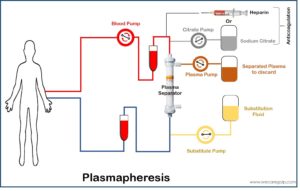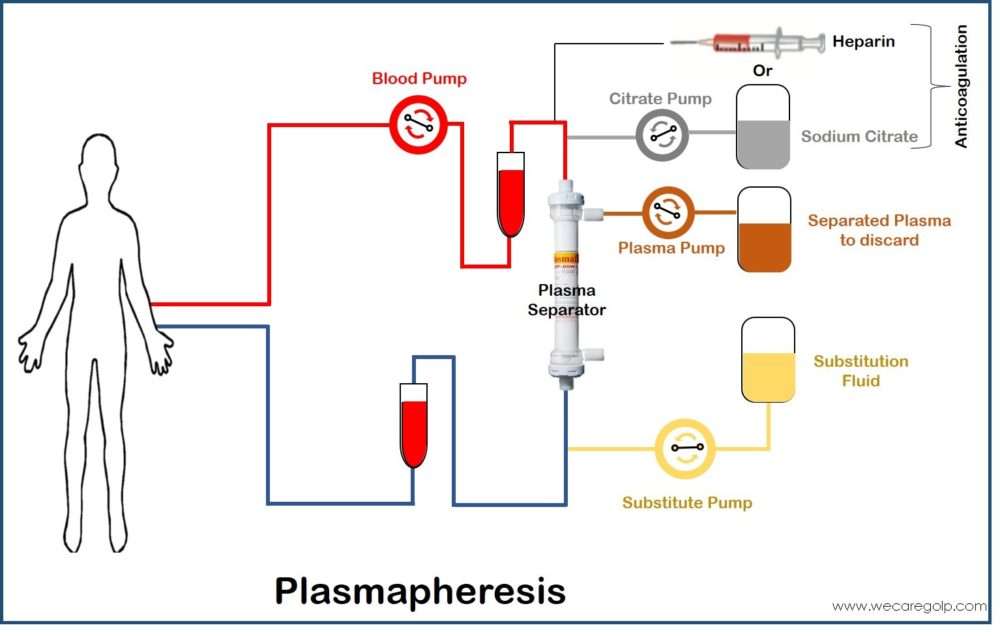Plasmapheresis
Plasmapheresis, also known as therapeutic plasma exchange (TPE), is a non-surgical therapy that removes and replaces a patient’s blood plasma.
- Plasma means the liquid part of the blood and apheresis means a particular substance or component is removed from the blood.
- It is done to exchange plasma in the blood through an extracorporeal technique.
- It eliminates pathologic substances (for example: antibodies, complement components, immunocomplexes, monoclonal proteins, cholesterol-containing lipoproteins, cryoglobulins, toxins bonded to proteins as well as other unknown substances) from the plasma or decreasing their concentration.
- In plasmapheresis, the entire plasma will discard and replace by colloidal solution (Plasma substitutes). Therefore, this method is called the unselective method.
Indications of Plasmapheresis
- Thrombotic Thrombocytopenic Purpura (TTP)
- Hyperviscosity syndrome
- Cryoglobulinemie
- Goodpasture´s syndrome
- Myasthenia gravis
- Guillain-Barre´syndrome (GBS)
- Systemic lupus erythematosus (SLE)
- Multiple sclerosis (MS)
- Neuromyelitis Optica (NMO)
- Chronic Inflammatory Demyelinating Polyneuropathy (CIDP)
- Rapidly Progressive Glomerulonephritis (RPGN)
- Immune thrombocytopenia (ITP)
- EHEC-Infection
- Acute desseminated encephalomyelitis
- Transplant sensitization
- Transplant rejection (antibody type)
- Waldenstrom’s Macroglobulinemia
- Recurring focal segmental glomerulosclerosis (FSGS)
- Other rarer diseases
Preparation for plasmapheresis
- Recommend to drink plenty of fluid (non-alcoholic) a couple of days prior to the procedure. It helps prevent fluid alteration and hypotension during and after the procedure.
- Recommend to eat normally before and even during therapy.
- Wear loose clothing. It can help the patient to stay comfortable and the health care provider to do the procedure.
- Discuss with the doctor about the medications before the procedure.
- Use the bathroom before the procedure.
- A vascular access (central venous catheter) needs to provide sufficient rate of blood flow through the machine.
- Monitor blood pressure, pulse, temperature as well as oxygen levels. It will help the care provider to set up the machine and monitor any changes that occur during the therapy.
Procedure of Plasmapheresis

- Generally, the blood coming from the patient first passes through a plasma separator with the help of the blood pump, in which the partial separation of the plasma from the blood cells takes place.
- While the cellular blood components return directly to the patient, the plasma separated by the membrane is collected in a collecting bag and weighed on the other hand.
- This separated plasma exchange with a plasma substitute. Meanwhile, a balancing system controls the exchange of both liquids.
- The heated substitute mixes with cellular blood components coming from the plasma separator and then returns to the patient.
- The procedure can take between two to three hours depends on patient´s condition. Basically, a patient may need as many as five or six therapies.
Besides a plasma separation machine and its accessories like extracorporeal system and plasma separator, you need the following.
Vascular access
- When performing a plasma separation with a plasma filter, a minimum blood flow of 50 ml/min is necessary.
- In principle, treatment via peripheral veins or catheters is possible.
- In most cases, plasmapheresis uses central venous access with a double-lumen catheter in the right internal jugular vein.
Anticoagulation
- Different methods use for anticoagulation.
- Continuous heparinization is preferred in therapy. Regular coagulation controls (PTT or ACT) before, during and after the treatment help to avoid extracorporeal coagulation as well as bleeding in the patient after the therapy.
- Sodium citrate is an alternative way of anticoagulation. Citrate has the property of neutralizing calcium by forming complexes and thus inhibiting blood clotting. However, it must be noted that there is a risk of hypocalcaemia.
Substitution fluid
When treating more than 1/3 of the plasma volume and frequent therapies, the discarded plasma must be replaced with a suitable liquid. There are three ways to replace plasma:
- Plasma protein: These substances consist of physiological concentrations of electrolytes, albumin and globulins.
- Fresh Frozen Plasma (FFP): The physiological plasma substitute requires ABO compatibility. It is particularly indicated if there is a fear of a lack of coagulation factors or immunoglobulins, e.g., in the case of thrombocytopenia or leukopenia
- Human albumin solution: Such solutions are made from 5% or better 20% albumin preparations and isotonic hemofiltration solutions (HF solutions). Allergic reactions rarely occur. Clinical studies show that human albumin solutions have a low rate of side effects compared to other plasma substitutes.
Side effects of plasmapheresis
Plasmapheresis can consider as a safe therapy. A few possible side effects are:
- Fluid alteration – breathless, cold hands and feet during or after the procedure
- Hypotension – including fainting, dizziness, blurred vision, or nausea
- Paraesthesia (tingling in the fingers and around the mouth)
- Fatigue
- Bleeding or allergic reaction (itching, wheezing, or rash)
- Blot clot in the machine (rare)
Complications of plasmapheresis
Like other therapy, Plasmapheresis also has some complications.
- Infections and bleeding – due to insertion of an intravenous catheter
- Bleeding – due to anticoagulation and depletion of clotting factors
- Allergic reactions – due to albumin or plasma
- Hypotension
- Electrolyte abnormalities (most commonly hypocalcaemia due to anticoagulation sodium citrate)
- Transmitted infections (e.g., HIV, hepatitis B and C but rare)
- Suppression of the patient´s immune system
References
- Plasmapheresis | Winchester Hospital
- Plasmapheresis and other extracorporeal filtration techniques in critical patients | Medicina Intensiva (medintensiva.org)
- Plasmapheresis: Definition and Patient Education (healthline.com)
- Therapeutic Plasma Exchange | Conditions & Treatments | UT Southwestern Medical Center (utswmed.org)
- The Role of Plasmapheresis in Critical Illness (nih.gov)
- Plasmapheresis: Definition and what to expect (medicalnewstoday.com)
- Plasmapheresis in MS Fact Sheet | Cleveland Clinic
- Plasmapheresis | Asahi Kasei Medical Co., Ltd. (asahi-kasei.co.jp)
- Plasmapheresis | Johns Hopkins Comprehensive Transplant Center (hopkinsmedicine.org)
- Plasmapheresis – Knowledge @ AMBOSS
- Plasmapheresis | National Multiple Sclerosis Society (nationalmssociety.org)

